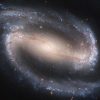The Magnetic Galaxy Far Far Away
Ever since the dawn of our species, humans have gazed up at the sky in wonder. What secrets do stars and moons and planets hold? What could they tell us about our own planet? What could they tell us about the universe at large? This general search for meaning is the driving force behind any of the sciences, astronomy notwithstanding.
One of astrophysics’ greatest mysteries is the role magnetism plays in the universe. We know it is crucial to blocking radiation and in the formation of new planets, but what does magnetism do for the universe? It turns out a galaxy far far away might hold some answers.
Located a mere 8 billion light years from Earth, this newly galaxy was first discovered by detecting its magnetic field. To researchers, it suggests that a galaxy’s magnetic field develops much earlier than we once thought.
What Does a Galaxy’s Magnetic Field Look Like?
Contrary to what you might expect, an entire galaxy has a magnetic field weaker than Earth’s. The reason? Galaxies are much older than most individual planets and their magnetic fields have had a longer time to weaken. The issue is, for the new galaxy just discovered, the magnetic field is much, much stronger than our own Milky Way. This tells researchers that the new galaxy is much younger than our own—about 5 billion years younger!
It has been posited that a galaxy’s magnetic field goes through a few changes in its life. When a galaxy first forms, the magnetism is extremely weak and barely able to sustain a prominent magnetic field. However, as the galaxy matures, so too does its magnetic field. The weaker, individual magnetic fields find each other, link up, and create a much stronger force.
The Mystery of Galactic Magnetism
Based on these findings, a team of international scientists have concluded that every celestial body must be (or was at one point) magnetic. If they aren’t, they at least have the potential to be. For some bodies, like Earth, it’s easy to figure out what contributes to its magnetism. Earth’s core is made mostly of molten iron and other ferromagnetic metals. As it began to spin, it created a dynamo effect and our magnetic field was born.
However, this doesn’t explain how every planet or galaxy gains their magnetism. Actually, no one’s quite sure. All we do know is that this magnetism is generated in the burgeoning stages of a galaxy’s formation. Scientists working in this research aren’t admitting defeat, though. Much like carbon dating the fossils of extinct animals, these magnetic readings from a long time ago in a galaxy far far away are the next big step to unraveling the magnetic mysteries of the universe.
As always, we’re here to break down all the latest magnetic news. Make sure to check out the rest of our blog for more attractive stories. Want even more magnetic news? Sign up for our monthly newsletter!

